LeoCentaur's Fractal Dipole Antennae
An sample of an indoor fractal antenna
In order to get the full benefit of the information presented here, you should have a basic understanding of antennae (i.e., what a full-wave, a half-wave and quarter-wave antennae are; transmission frequency and its correlation to wave length, etc.). Also you should be familiar with fractal antennae design (if not, go to this URL for a lesson in the basics http://ruckman.net/blog/news.php?item.21.4 ).
On June 12, 2009, like millions of other people, we lost our analog TV stations, left with nothing but static on the tv screen. My brother and I had discussed making a fractal antenna for DTV reception but I was unconvinced that it would work. My brother made an antenna; lo and behold! it worked. He managed to pick the signal from a couple of stations. This was amazing to me as there was no clear path to the transmission station (one of a number of fallacies being perpetuated about DTV transmission signals); he was in his room with the window closed just pointing the antenna around and picking up a signal; the backyard is completely surrounded by tall trees. And so, it began.
Powered by WebRing®.
|
As with all our projects, we try to use stuff around the house. We used aluminum pans for reflectors on the antennae, scraps of 1/14" plywood for mounting the elements and even a piece of Plexiglas left over from a previous project. The only things that have been purchased for this project are screws, washers and painting supplies. The cost of this project so far is $45.
This is one of our earlier designs. We found that the reflectors are actually a hindrance in receiving signals and we do not use them. We discovered rather late in the game that rectangular fractal antennae are far more compact than the triangular design and suggest that you use the rectangular design especially if you are constructing antennae for the lower frequencies or if you want a full-wave antenna. (A note of caution: When constructing full-wave, half-wave or quarter-wave antennae, it is better to make them a little longer that the actual wave length that you desire).
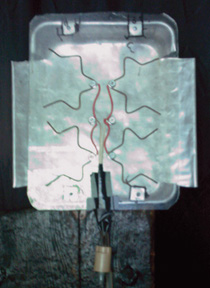
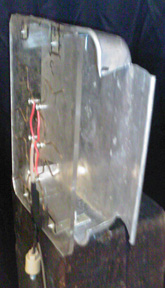
The design ideas for our fractal antennae came from http://ruckman.net/blog/news.php?item.21.4
If you live near the DTV transmission source, this antenna would work great. It works better than the 'rabbit ears' antennae did with analog reception. If you live in an area where there might be a lot of signal bounce, you may want to put a reflector on the antenna to keep out unwanted signal bounce.
There are a few differences in the materials we used to construct our antennae. We used 12 gauge copper radio antenna wire for the elements. The advantage of using a large gauge wire is that the mounting plate (we used 1/4" plywood) only has to be big enough to accommodate the mounting screws which minimizes wind resistance on the mounting plate in outdoor use. We made fractal elements of 1" (8" wire length), 1 1/2" (12" wire length), 2" (16" wire length) and 2 1/2" (20" wire length).
Our current antenna array consists of eleven fractal antennae (full-wave, half-wave and quarter-wave) designed to receive a particular frequency and fourteen straight rod elements.
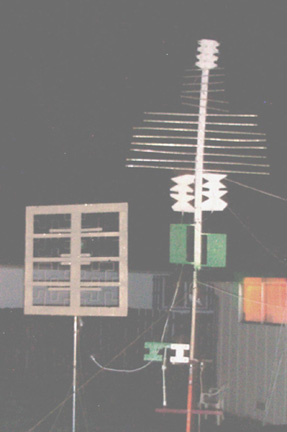
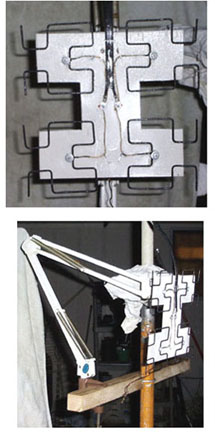
The picture on the left is the complete antenna array. Each antenna element is directed towards the origin of a specific DTV signal. The picture on the right is a fractal antenna of the rectangular design and of a ratio of one inch to two inches (the short sections are 1" and the longer sections are 2"). It is mounted on a lamp base that allows it to be pointed in any direction.
The antenna array feeds signals to two television digital to analog converter boxes each having its own 300 ohm to 75 ohm transformer on the antenna array. We have found that the use of signal splitters is not advisable as the weakens the signal, having each TV on it own 75 ohm transformer hooked into the antenna works quite well. Also, the shortest length of cable from the antenna to the converter box is of supreme importance. We do not advise using TV signal amplifiers (unless absolutely necessary) because we have found that they can block certain frequencies from reaching the converter box.
Another fallacy is that higher is better (not unless your antenna can reach up 60 to 80 feet or more). After numerous attempts to get a good signal by raising the antenna array up 30 feet, we discovered that closer to the ground is better; Signal strength improved it was easier to position the antenna to get a good signal.
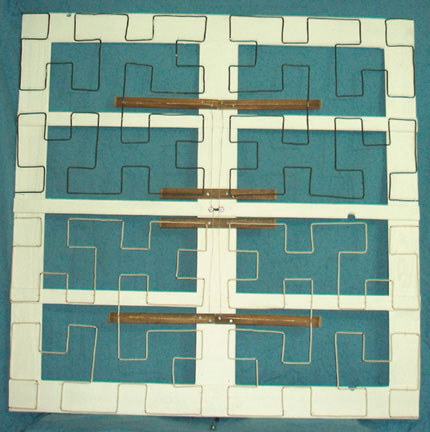
This is a level-3 fractal, rectangular, dipole antenna. It is a full-wave antenna designed to receive signals at 60MHz and above. The short lengths are three inches, the long lengths are six inches and the mid-point section is nine inches. The wire length of each of the four elements of the antenna is 15.75 feet for a total of sixty-three feet for the whole unit. The center mast is quarter inch plywood and the frame is made of light-weight cedar. The antenna weights less than ten pounds.
My brother's latest effort with the rectangular fractal antenna design.
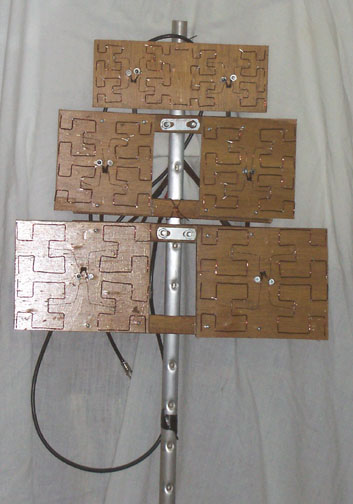
This antenna array is about one-quarter the size of an equivalent triangular antenna design. In initial tests this antenna alone, pulled in and held signals from five different TV stations.
|
Click on the image for a more detailed view of the construction.
|
This is a spiral di-pole antenna design. This a prototype test model. I was able to pull in the elusive signal from Channel 11 with this antenna. (Not that there is anything worth watching on Channel 11. It's the same old crap that they have been broadcasting for years. Why in the hell does anybody watch TV anyway?) This model is very compact containing almost as much wire as the level-3 fractal, rectangular, dipole antenna (seen above). This antenna was designed with the idea that it would be omni-directional. However, in testing the antenna, this proved not to be the case. The next generation of this model will be about twenty-eight inches high and have at least four elements each consisting of fifteen feet of wire; the spiral circles will be about four to five inches in diameter. Lately, I have been using 12 gauge solid conductor, electrical wire in making my antennae (because I have used up every other kind of wire that was around the house. Damn! Now I'll have to go down to the Habitat for Humanity Re-Store and see if I can find something to make antennae). |
|
This is the next generation of spiral di-pole antenna design. This design achieved the omni-directionallity hoped for in the prototype. It has a hexanganol shape with six sets of elements. The wire in each element is fifteen feet long with a diameter of about 3 1/2 to 4 inches. The unit is about twenty-eight inches high and is twenty-eight inches wide at the base (from point to point). |
We have at one time or other received a signal from every station broadcasting within a sixty mile radius. However, good reception is intermittent and only a few stations have a reliable signal.
These are the stations from which we receive the most reliable signal:
| Transmission Frequencies | Distance/Direction from our antenna | Signal Strength Rating |
| 211/215Mhz | 36 Miles - 343 Degrees from north | Excellent |
| 555/559Mhz | 27 Miles - 22 Degrees from north | Fair |
| 585/589Mhz | 51 Miles - 33 Degrees from north | Moderate (Poor during winter) |
We receive these stations' signals on an intermittent basis:
| Transmission Frequencies | Distance/Direction from our antenna | Signal Strength Rating |
| 67/ 71Mhz | 47 miles - 10 Degrees from north | Very Poor |
| 77/ 81Mhz | 47 miles - 10 Degrees from north | Very Poor |
| 175/179Mhz | 47 miles - 10 Degrees from north | Very Poor |
| 187/191Mhz | 47 miles - 13 Degrees from north | Poor |
| 199/203Mhz | 47 miles - 13 Degrees from north | Fair |
| 477/481Mhz | 35 miles - 182 Degrees from north | Very Poor |
| 483/487Mhz | 47 miles - 10 Degrees from north | Very Poor |
| 519/523Mhz | 47 miles - 13 Degrees from north | Poor |
| 651/655Mhz | 51 miles - 33 Degrees from north | Poor |
(This page was updated on January 4, 2010)
This page will be updated as we obtain results from our experiments.
If you have any comments or questions e-mail us and we will try to get back to you as soon as possible.
![]()
There seems to very little information available on this subject. Help is needed to make more information easily accessible to the public. I believe that the fascist telecommunications industry is league with the government to drive everyone into cable and satellite TV subscriptions. Don't let the fascists win! Help make more information available to the public.
The Tigerstedt Memorial Chess Set - https://leocentaur.angelfire.com/tmchess.html
LeoCentaur's Theremin Page - https://leocentaur.angelfire.com/theremin.html
A Satirical Take on The Revolutionary Switch to Digital Television - https://leocentaur.angelfire.com/dtv1.html
E-books: The Memoirs of John F. Doe - https://leocentaur.angelfire.com/alitw.html
Stand-Alone File Sort Utility for Windows 95/98/ME/2000/XP - https://leocentaur.angelfire.com/wrqsort.html